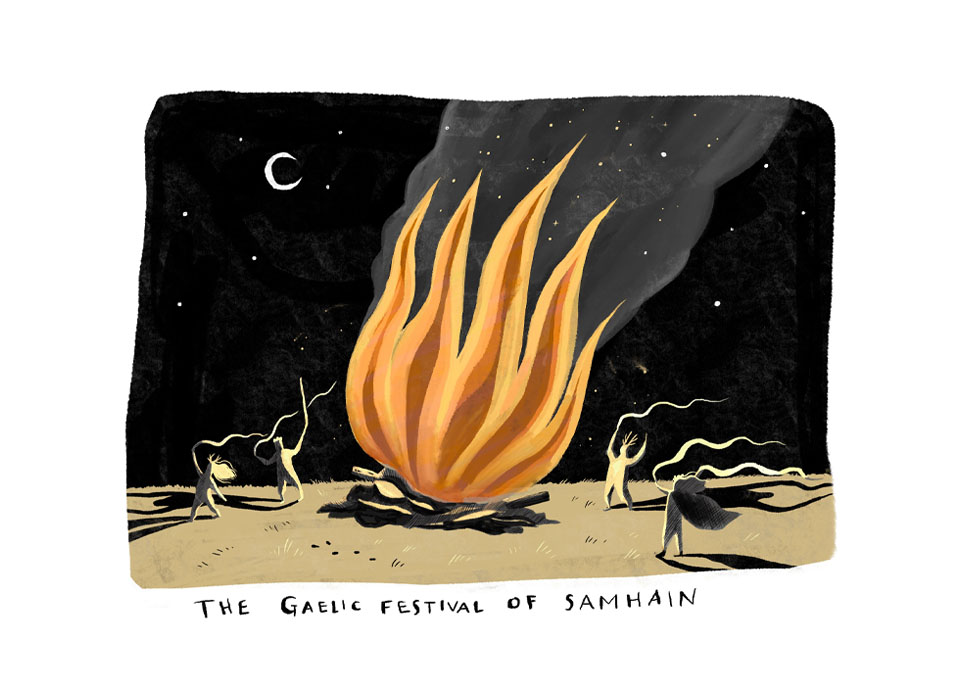
The end of October means just one thing: Halloween! I love celebrating this spooky autumn holiday. However it was only recently that I actually took the time to learn more about the history of Halloween.
While researching All Hallows Eve and Samhain, I also enjoyed discovering traditional autumn activities connected to Halloween. If spooky season is your favourite time of year, I’ve got a cauldron full of historical knowledge and activities for you. As well as some tips on how I use my Billy Gift customised notebook for research, for you to enjoy.

The History of Halloween
Cultures around the world have holidays that are centred around the connection between life and death. In the UK, the history of Halloween is generally agreed to have its roots in the Celtic festival of Samhain. The Celts, who lived in western Europe and most notably Great Britain, celebrated Samhain between the fall equinox and the winter solstice, at the end of October. They believed that the barrier between the living world and the world of souls and spirits was at its thinnest at this time when the harvest ended and the dark winter nights began.
A central part of the Samhain celebrations was the lighting of a large, communal bonfire. People would use this to relight the fires in their houses after the celebrations. The Celts would also perform animal sacrifices and leave offerings to protect themselves from malicious spirits throughout the upcoming year. As well as dress in costumes to confuse fairies!

As Christianity spread throughout Europe, the church was eager to replace pagan traditions with its own holidays. A previous holiday called All Martyrs Day, which was celebrated in May as an opportunity to celebrate the many Christian saints and martyrs, was moved to the beginning of November around 1,000AD and renamed All Souls Day. With its large bonfires and parades, the celebrations for this holiday were in some ways very similar to Samhain. Individuals would also dress up as angels and devils. All Saints Day was also known as All-Hallowmas, from the Middle English word for the celebration. And so the night before the celebration became known as All Hallows Eve, which eventually evolved into Halloween.
Historical Halloween activities
From the bonfires of Samhain to trick-or-treating in modern America, Halloween is filled with traditions and activities. And they very often have their roots in warding off evil spirits and celebrating the weird and spooky!
Activities are often linked to the season, for example changing your face and dress are an important part of Halloween celebrations in all its historical iterations, possibly because autumn is a time of change as the year shifts from sunny summer to cold winter.

As the end of October is also the end of the harvest in the UK, fruit and vegetables are often used in Halloween celebrations. Did you know that pumpkin carving originated as the carving of turnips, pumpkins or beets?
Bobbing for apples has also become one of the more well-known Halloween activities. Around the 18th and 19th century, Halloween became a popular time for single women to try to predict their marriage prospects. When bobbing for apples, the first woman to catch an apple would supposedly be the first to marry. Another apple themed method was to toss the fruit’s peel over your shoulder. This would supposedly reveal the first letter of your future husband’s name.
The creepiest method of foreseeing your husband on Halloween was to stand in front of a mirror in a dark room with just a candle. Supposedly, your future husband’s face would appear in the glass!

Using notebooks for research
I love opportunities to learn, but sometimes I can struggle to keep all the information straight, especially with the number of tabs I end up having open! Many students writing dissertations use Bullet Journaling to help them keep track of their ideas, notes, and research. And, of course, the dreaded deadline timelines! We’ve talked about the benefits of Bujo before, but the ability it offers for connecting different ideas can be really useful for big research projects as well.
Other ways of making new knowledge easier to digest can include breaking up notes into shorter sections within notebooks. Or by adding bright colours, images and fancy fonts to make the information more eye-catching and fun to read over.

Parties and adventures are all well and good. But curling up on the sofa with a seasonal movie, a hot spiced drink, and a fun research project might be a much more appealing Halloween activity for an introvert or a highly sensitive person. Or if you fancy a spot of last minute decorating this weekend, check out our tutorials for three autumn crafts.
We hope you learned a little on the history of Halloween and have been inspired to try out a spooky activity or two. Which ever way you decide to celebrate the spooky season, we hope you have a frightfully fun time! And don’t forget there’s still a couple of days left to make spooky savings on our Halloween and Autumn notebooks. Just add the code “HALLOWEEN” at the checkout for 50% off.
Happy Halloween!





